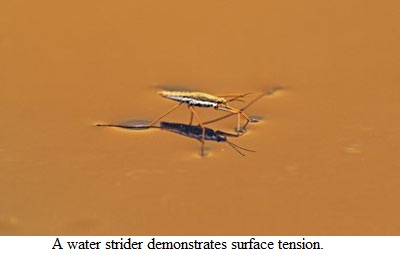|
|
|
|
 The
hydrogen bond between water molecules that we talked about in the first
section is the reason behind two of water's unique properties: cohesion
and adhesion. Cohesion refers to the fact that water sticks to itself
very easily. Adhesion means that water also sticks very well to other
things, which is why it spreads out in a thin film on certain surfaces,
like glass. When water comes into contact with these surfaces, the
adhesive forces are stronger than the cohesive forces. Instead of
sticking together in a ball, it spreads out. The
hydrogen bond between water molecules that we talked about in the first
section is the reason behind two of water's unique properties: cohesion
and adhesion. Cohesion refers to the fact that water sticks to itself
very easily. Adhesion means that water also sticks very well to other
things, which is why it spreads out in a thin film on certain surfaces,
like glass. When water comes into contact with these surfaces, the
adhesive forces are stronger than the cohesive forces. Instead of
sticking together in a ball, it spreads out.
Water also has a high level of surface tension. This means that the
molecules on the surface of the water are not surrounded by similar
molecules on all sides, so they're being pulled only by cohesion from
other molecules deep inside. These molecules cohere to each other
strongly but adhere to the other medium weakly. One example of this is
the way that water beads up on waxy surfaces, such as leaves or waxed
cars. Surface tension makes these water drops round so they cover the
smallest possible surface area.
Capillary action is also a result of surface tension. As we mentioned,
this happens in plants when they "suck up" water. The water adheres to
the inside of the plant's tubes, but the surface tension attempts to
flatten it out. This makes the water rise and cohere to itself again, a
process that continues until enough water builds up to make gravity
begin pulling it back down.
Water's hydrogen bonds are also why its solid form, ice, can float on
its liquid form. Ice is less dense than water because water molecules
form crystalline structures at freezing (32 degrees Fahrenheit or 0
degrees Celsius) temperatures. The thermal properties of water are also
linked to its hydrogen bonds. Water has a very high specific heat
capacity, which is the amount of heat per unit mass required to raise
its temperature by one degree Celsius. The energy required to raise the
temperature of water by one degree Celsius is 4.2 joules per gram. Water
also has a high heat of vaporization, which means that it can take a lot
of heat without its temperature rising much. This plays a huge part in
the climate, because it means that oceans take a long time to warm up.
Water is often known as the universal solvent, which means that many
substances dissolve in it. Substances that dissolve in water are
hydrophilic. This means that they are as strong or stronger than water's
cohesive forces. Salt and sugar are both polar, like water, so they
dissolve very well in it. Substances that do not dissolve in water are
hydrophobic. This is the source of the saying "oil and water don't mix."
Water's solvency is why the water that we use is rarely pure; it usually
has several minerals dissolved in it.
The presence of these minerals is the difference between hard water and
soft water. Hard water usually contains a lot of calcium and magnesium,
but may also contain metals. Soap will not lather well in hard water,
but hard water isn't usually dangerous. It can also cause lime scale
deposits in pipes, water heaters and toilets.
Some of the latest controversy about water's properties lies in how ice
behaves when it melts. Some scientists claim that it looks about the
same as it does when it's solid, except that some of its hydrogen bonds
are broken. Others claim that it forms an entirely new structure. So for
all of its importance, we still don't completely understand water.

Source: http://science.howstuffworks.com |
|


 The
hydrogen bond between water molecules that we talked about in the first
section is the reason behind two of water's unique properties: cohesion
and adhesion. Cohesion refers to the fact that water sticks to itself
very easily. Adhesion means that water also sticks very well to other
things, which is why it spreads out in a thin film on certain surfaces,
like glass. When water comes into contact with these surfaces, the
adhesive forces are stronger than the cohesive forces. Instead of
sticking together in a ball, it spreads out.
The
hydrogen bond between water molecules that we talked about in the first
section is the reason behind two of water's unique properties: cohesion
and adhesion. Cohesion refers to the fact that water sticks to itself
very easily. Adhesion means that water also sticks very well to other
things, which is why it spreads out in a thin film on certain surfaces,
like glass. When water comes into contact with these surfaces, the
adhesive forces are stronger than the cohesive forces. Instead of
sticking together in a ball, it spreads out.